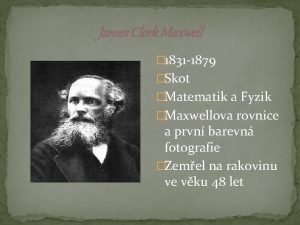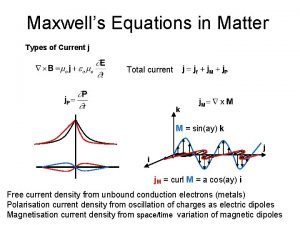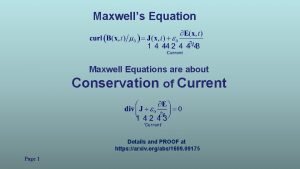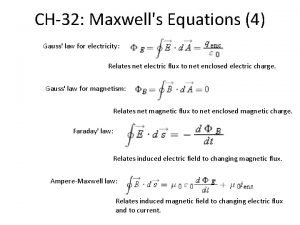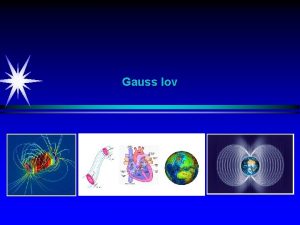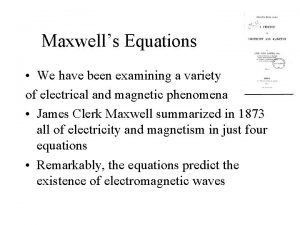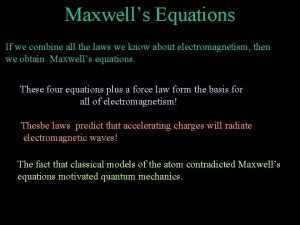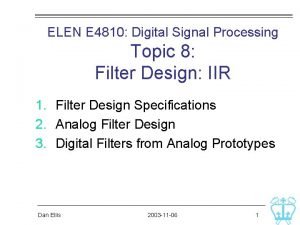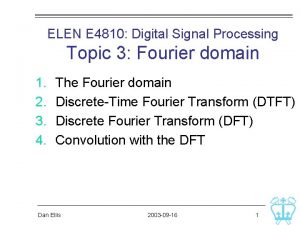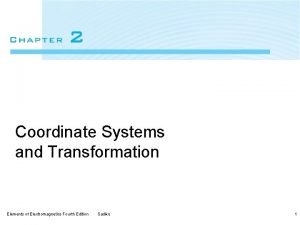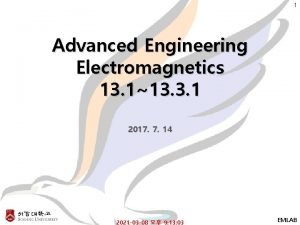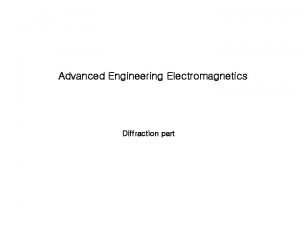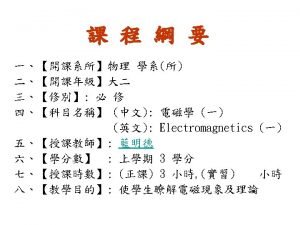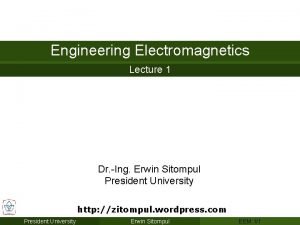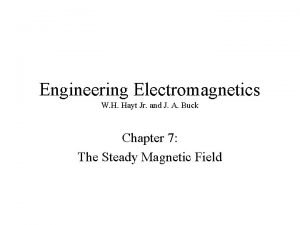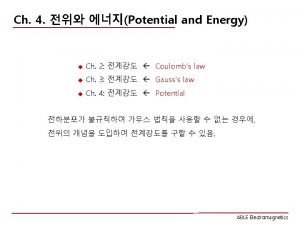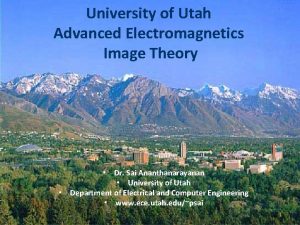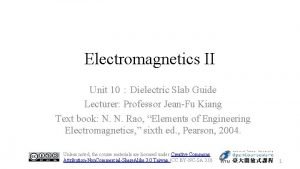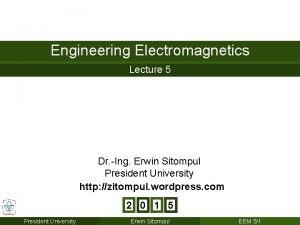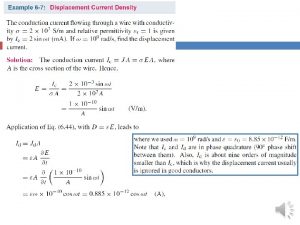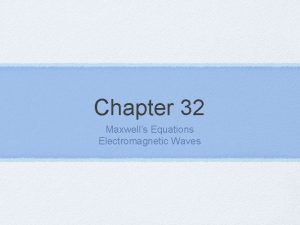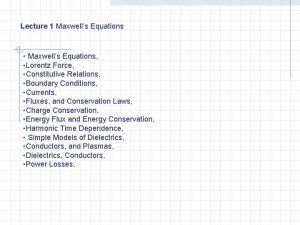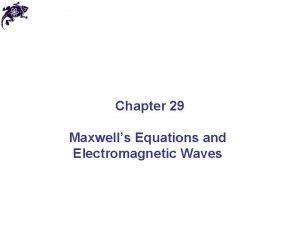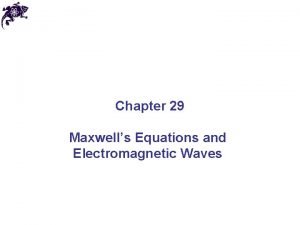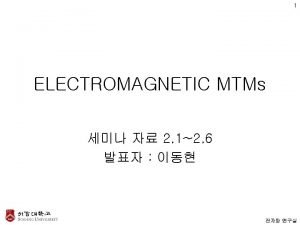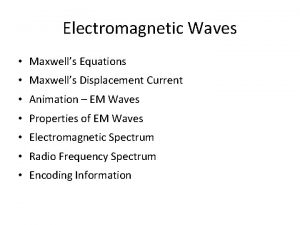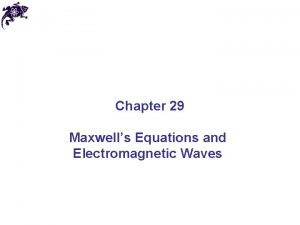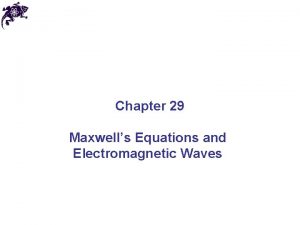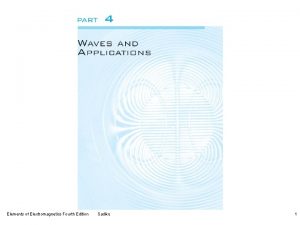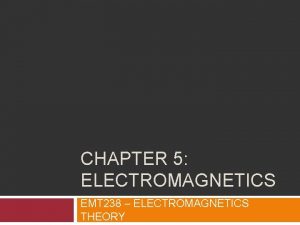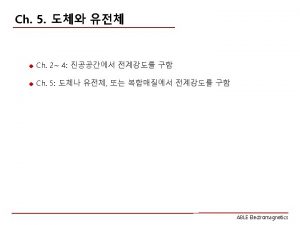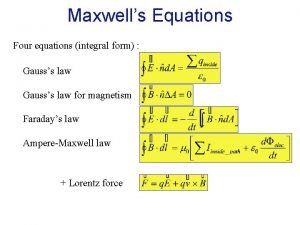1 Maxwells Equations ELEN 3371 Electromagnetics Fall 2008























- Slides: 23

1 Maxwell’s Equations ELEN 3371 Electromagnetics Fall 2008

2 Maxwell’s Equations The behavior of electric & magnetic waves can be fully described by a set of four equations (which we learned already). Faraday’s Law of Induction: Ampere’s Law: Gauss’s Law for Electricity: Gauss’s Law for Magnetism: ELEN 3371 Electromagnetics Fall 2008

3 Maxwell’s equations And the constitutive relations: (6. 3. 1) (6. 3. 2) (6. 3. 3) They relate the electromagnetic field to the properties of the material, in which the field exists. Together with the Maxwell’s equations, the constitutive relations completely describe the electromagnetic field. Even the EM fields in a nonlinear media can be described through a nonlinearity existing in the constitutive relations. ELEN 3371 Electromagnetics Fall 2008

4 Maxwell’s equations Integral form Faraday’s Law of induction (6. 4. 1) Ampere’s Law (6. 4. 2) Gauss’s Law for electricity (6. 4. 3) Gauss’s Law for magnetism (6. 4. 4) ELEN 3371 Electromagnetics Fall 2008

5 Maxwell’s equations Example 6. 1: In a conductive material we may assume that the conductive current density is much greater than the displacement current density. Show that the Maxwell’s equations can be put in a form of a Diffusion equation in this material. (6. 5. 1) We can write: and, neglecting the displacement current: (6. 5. 2) Taking curl of (6. 5. 2): (6. 5. 3) Expanding the LHS: (6. 5. 4) The first term is zero and (6. 5. 5) Is the diffusion equation with a diffusion coefficient D = 1/( 0) ELEN 3371 Electromagnetics Fall 2008

6 Maxwell’s equations Example 6. 2: Solve the diffusion equation for the case of the magnetic flux density Bx(z, t) near a planar vacuum-copper interface, assuming for copper: = 0 and = 5. 8 x 107 S/m. Assume that a 60 -Hz time-harmonic EM signal is applied. Assuming ej t time-variation, the diffusion equation is transformed to the ordinary differential equation: (6. 6. 1) Where z is the normal coordinate to the boundary. Assuming a variation in the z-direction to be Bx(z) = B 0 e- z, we write: (6. 6. 2) ELEN 3371 Electromagnetics Fall 2008

7 Maxwell’s equations The magnitude of the magnetic flux density decays exponentially in the z direction from the surface into the conductor (6. 7. 1) where (6. 7. 2) The quantity = 1/ is called a “skin depth” - the distance over which the current (or field) falls to 1/e of its original value. For copper, = 8. 5 mm. ELEN 3371 Electromagnetics Fall 2008

8 Maxwell’s equations Example 6. 3: Derive the equation of continuity starting from the Maxwell’s equations The Gauss’s law: (6. 8. 1) Taking time derivatives: (6. 8. 2) From the Ampere’s law (6. 8. 3) Therefore: (6. 8. 4) The equation of continuity: (6. 8. 5) ELEN 3371 Electromagnetics Fall 2008

9 Poynting’s Theorem It is frequently needed to determine the direction the power is flowing. The Poynting’s Theorem is the tool for such tasks. We consider an arbitrary shaped volume: Recall: (6. 9. 1) (6. 9. 2) We take the scalar product of E and subtract it from the scalar product of H. (6. 9. 3) ELEN 3371 Electromagnetics Fall 2008

10 Poynting’s Theorem Using the vector identity (6. 10. 1) Therefore: (6. 10. 2) Applying the constitutive relations to the terms involving time derivatives, we get: (6. 10. 3) Combining (6. 9. 2) and (6. 9. 3) and integrating both sides over the same v… ELEN 3371 Electromagnetics Fall 2008

11 Poynting’s Theorem (6. 11. 1) Application of divergence theorem and the Ohm’s law lead to the PT: (6. 11. 2) Here (6. 11. 3) is the Poynting vector – the power density and the direction of the radiated EM fields in W/m 2. ELEN 3371 Electromagnetics Fall 2008

12 Poynting’s Theorem The Poynting’s Theorem states that the power that leaves a region is equal to the temporal decay in the energy that is stored within the volume minus the power that is dissipated as heat within it – energy conservation. EM energy density is (6. 12. 1) Power loss density is (6. 12. 2) The differential form of the Poynting’s Theorem: (6. 12. 3) ELEN 3371 Electromagnetics Fall 2008

13 Poynting’s Theorem Example 6. 4: Using the Poynting’s Theorem, calculate the power that is dissipated in the resistor as heat. Neglect the magnetic field that is confined within the resistor and calculate its value only at the surface. Assume that the conducting surfaces at the top and the bottom of the resistor are equipotential and the resistor’s radius is much less than its length. The magnitude of the electric field is (6. 13. 1) and it is in the direction of the current. The magnitude of the magnetic field intensity at the outer surface of the resistor: (6. 13. 2) ELEN 3371 Electromagnetics Fall 2008

14 Poynting’s Theorem The Poynting’s vector (6. 14. 1) is into the resistor. There is NO energy stored in the resistor. The magnitude of the current density is in the direction of a current and, therefore, the electric field. (6. 14. 2) The PT: (6. 14. 3) (6. 14. 4) The electromagnetic energy of a battery is completely absorbed with the resistor in form of heat. ELEN 3371 Electromagnetics Fall 2008

15 Poynting’s Theorem Example 6. 5: Using Poynting’s Theorem, calculate the power that is flowing through the surface area at the radial edge of a capacitor. Neglect the ohmic losses in the wires, assume that the radius of the plates is much greater than the separation between them: a >> b. Assuming the electric field E is uniform and confined between the plates, the total electric energy stored in the capacitor is: (6. 15. 1) The total magnetic energy stored in the capacitor is zero. ELEN 3371 Electromagnetics Fall 2008

16 Poynting’s Theorem The time derivative of the electric energy is (6. 1) This is the only nonzero term on the RHS of PT since an ideal capacitor does not dissipate energy. We express next the time-varying magnetic field intensity in terms of the displacement current. Since no conduction current exists in an ideal capacitor: (6. 16. 2) Therefore: (6. 16. 3) ELEN 3371 Electromagnetics Fall 2008

17 Poynting’s Theorem The power flow would be: (6. 17. 1) In our situation: (6. 17. 2) and (6. 17. 3) Therefore: (6. 17. 4) We observe that (6. 17. 5) The energy is conserved in the circuit. ELEN 3371 Electromagnetics Fall 2008

18 Time-harmonic EM fields Frequently, a temporal variation of EM fields is harmonic; therefore, we may use a phasor representation: (6. 18. 1) (6. 18. 2) It may be a phase angle between the electric and the magnetic fields incorporated into E(x, y, z) and H(x, y, z). Maxwell’s Eqn in phasor form: (6. 18. 3) (6. 18. 4) (6. 18. 5) (6. 18. 6) ELEN 3371 Electromagnetics Fall 2008

19 Time-harmonic EM fields Power is a real quantity and, keeping in mind that: (6. 19. 1) complex conjugate Since (6. 19. 2) Therefore: (6. 19. 3) Taking the time average, we obtain the average power as: (6. 19. 4) ELEN 3371 Electromagnetics Fall 2008

20 Time-harmonic EM fields Therefore, the Poynting’s theorem in phasors is: (6. 20. 1) Total power radiated from the volume The energy stored within the volume Indicates that the power (energy) is reactive ELEN 3371 Electromagnetics Fall 2008 The power dissipated within the volume

21 Time-harmonic EM fields Example 6. 6: Compute the frequency at which the conduction current equals the displacement current in copper. Using the Ampere’s law in the phasor form, we write: (6. 21. 1) Since (6. 21. 2) and (6. 21. 3) Therefore: (6. 21. 4) Finally: (6. 21. 5) At much higher frequencies, cooper (a good conductor) acts like a dielectric. ELEN 3371 Electromagnetics Fall 2008

22 Time-harmonic EM fields Example 6. 7: The fields in a free space are: (6. 22. 1) Determine the Poynting vector if the frequency is 500 MHz. In a phasor notation: (6. 22. 2) And the Poynting vector is: (6. 22. 3) HW 5 is ready ELEN 3371 Electromagnetics Fall 2008

23 What is diffusion equation? The diffusion equation is a partial differential equation which describes density fluctuations in a material undergoing diffusion. Diffusion is the movement of particles of a substance from an area of high concentration to an area of low concentration, resulting in the uniform distribution of the substance. Similarly, a flow of free charges in a material, where a charge difference between two locations exists, can be described by the diffusion equation. Back ELEN 3371 Electromagnetics Fall 2008
 Maxwells equations
Maxwells equations Maxwell's equations in matter
Maxwell's equations in matter Maxwell.equations
Maxwell.equations Maxwells laws
Maxwells laws Enheten gauss
Enheten gauss Maxwell correction to ampere's law
Maxwell correction to ampere's law Maxwell equations
Maxwell equations 2008 2008
2008 2008 Elen johad
Elen johad Elen 4810
Elen 4810 Elen 4810
Elen 4810 Elen tisler
Elen tisler Elen kihl
Elen kihl Electromagnetics
Electromagnetics Advanced engineering electromagnetics
Advanced engineering electromagnetics Engineering electromagnetics
Engineering electromagnetics Cheng field and wave electromagnetics
Cheng field and wave electromagnetics Dot ing
Dot ing Biot savart law
Biot savart law Able electromagnetics
Able electromagnetics Able electromagnetics
Able electromagnetics Image theory in electromagnetics
Image theory in electromagnetics Electromagnetics
Electromagnetics Engineering electromagnetics
Engineering electromagnetics
